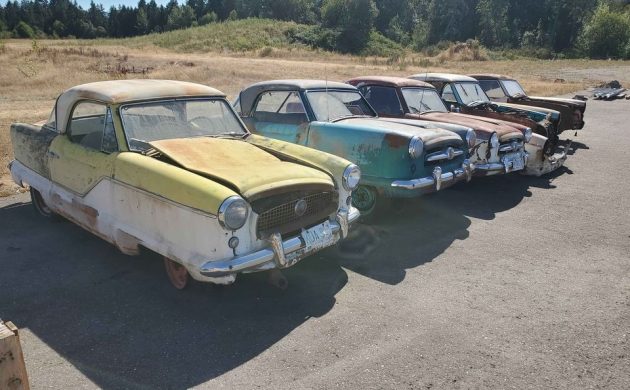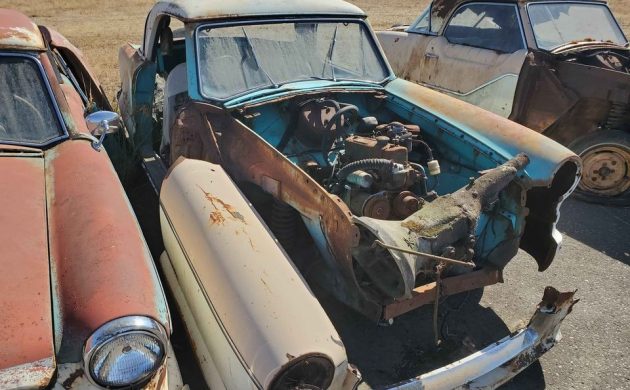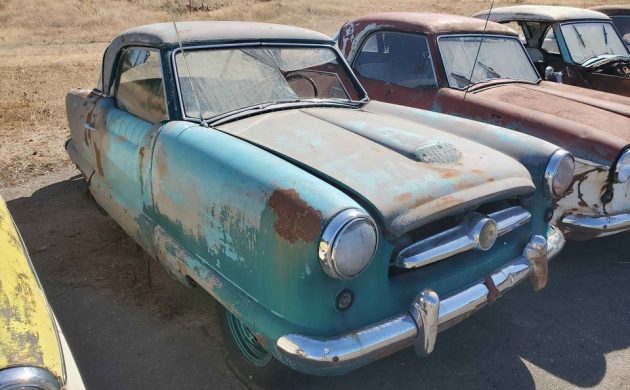When it comes to affordable project cars, they don’t come much cheaper than this collection of Nash (and Hudson) Metropolitans. Built in Britain, the car remained on sale between 1954 and 1962. By the standards of today, the Metropolitan didn’t sell in significant numbers. However, a final tally of 95,000 vehicles wasn’t bad for what was probably one of America’s first genuine sub-compact offerings. Today, these little classics have developed something of a cult following. This seller has a total of five of these little gems that he wants to part with, and they make a compelling argument no matter how you look at them. Four of the cars have motors, and four also have titles. They are located in Silverdale, Washington, and have been listed for sale here on Facebook. You can take your pick from the collection at a mere $300 per car. If you struggle to choose, you could hand the owner $1,200 and take the entire collection home. I have to say a huge thank you to Barn Finder Jay B for referring this great little collection to us.
When you look across this cluster of classics, you find that three of the vehicles wear Nash badges, while the remaining two are Hudson variants. There’s little to choose between the two makes beyond a few badges, although it appears that the vehicles that we will nominally refer to as the Hudson variants might be the oldest of the bunch. Both cars feature the distinctive but decorative hood scoop, which is absent on the other vehicles. The other three Metros feature an opening trunk lid, which indicates that they were built around or after early 1959. Some of the cars have accumulated their share of dents and scars over the year, but it isn’t clear whether they have any rust lurking below the surface. Still, with such a wide selection on offer, potential buyers could easily cherry-pick the best of the bunch to serve as the base for their project build.
Four of these little Metros have engines under the hood, and these should all be the venerable BMC 1,498cc B-Series four. Bolted to the back of this four-pot is a 3-speed manual transmission, and depending on the vehicle, the power output would be between 52hp and 55hp. Hardly a startling figure, I know. However, the Metropolitan was conceived as a second car for most households, so it was perceived as a car that would see most of its miles in the cities and suburbs. The beauty of these cars as project vehicles is that almost every mechanical component remains readily available today. Even the often troublesome electrical system can be binned because new reproduction wiring harnesses are easy and cheap to find without all of the legendary Lucas glitches. We don’t receive any information or photos of the interiors, but you would get decent odds that all will be ready for restoration. Once again, finding trim items is not difficult, nor is finding some of the hard trim pieces like handles and knobs. Of course, if someone hands over the cash for the entire collection, they might find themselves with more parts than they know what to do with.
Hindsight is always 20:20 vision. During its production life, the Metropolitan sold in pretty respectable numbers. At one point, it was the highest-selling imported vehicle in the United States. However, its sales volumes weren’t all that the company had hoped for. It isn’t clear how many of the original 95,000 cars remain in active service today, but it seems widely accepted that the figure is somewhere around the 6,000 mark. When you look at the current new car market and the industry drive towards more fuel-efficient vehicles, it makes a case that the Metro was a sub-compact ahead of its time. I would love to think that buyers will resurrect all of these little classics, but I know that the odds are firmly stacked against this happening. Would you be willing to tackle a Metropolitan restoration, or would you bite the bullet and take the entire collection home?





I went to Houston in 1964 as an 11-year old and rode around in one owned by my uncle. He drove, my dad was in the passenger seat, and I was in the stowaway section. His was turquoise and white and ran perfectly. Looking back I’m surprised it had enough power to chug along with all 3 of us.
Buy the lot! B-series? Anything you can do to an MGB, you can do to these. The Rover V-8 might even fit…
P.S. John Cleland is a radge.
https://www.youtube.com/watch?v=dUGjKX_2u2E
It’s confusing, but the “B” series engine is the MGA1500 engine with one carb. Cheap improvement would be to install a MGB engine. They are 1800 cc., about 90HP (except the later smog choked), and should bolt in.
I think originally they had a 4 speed gearbox,which was altered to 3 speed.Built at “The Austin”(Longbridge) they were known as “Hairdresser’s Cars”.
they were 3 on the tree never offered a 4 speed rode in many of these
I read the transmission is an austin 4 speed with 1st gear blocked off. So 1st gear is really second and and second is really third. And so on…
No,the gearbox was 4 speed,with first blocked off.The UK cars had 3 speed column change(On the tree if you prefer).
It was a 4-speed gearbox with the top gear removed.
I have a 59 Metropolitan with the 1500cc engine , originally had a single barrel Zenith carb . I replaced it with a Weber 34ICH which is a better carb. It has a 3 on the tree manual gearshift with a Hydraulic clutch , slave cylinder . Will do about 65 mph easily .
Damn, another steal today. I’ve seen these from stock to blown pro street and like them all
I think 2 waggys were made, 1 survives. I’d attempt a conversion w/1 – 3 of these as a DD.
Hunker it down, frame stiffeners, turbo from a VW 1.2, 4 discs, etc. Now call it a hairdresser’s. If so U can run ur fingers thru mine while I run an SCCA course~
The wagon was an experiment with a smaller. cheaper car than the 1956-up 108″ wb senior Rambler that was still more capable of being a family’s prime mover than the standard Met coupe. It was passed over in favor of the resurrected ’55 Rambler 100″ wb 2-door sedan, the first American.
On your mark, get set, oh never mind.
A friend of my dad’s was general counsel for American Motors back in the day. His daughters lamented that they had to drive Ramblers in high school, but their mom had a Metropolitan and didn’t seem to mind it at all.
I think they’re classics but then I’m somewhat prejudiced. The real question is would you rather drive one of these or a Smart Car?
I always thought it was a shame that as maneuverable as these were they could’ve been so much better if Nash opened up the front wheelwells and gotten Austin to use the FX3/FX4 London Taxi steering setup.
2 of these currently for sale sitting along rt 20 just west of Woodville, Oh. In much better shape.
For that price, I’d buy the whole fleet. Seems like there would be many benefits to having/working on several at one time.
My first car was a Nash Metro. Time has not lessened my recollection of what an utter piece of &*#$ that little &%&* was.
The Series 1 and 2 cars were actually 1200 engines – not until series 3 was the 1500 stock in the Metro.